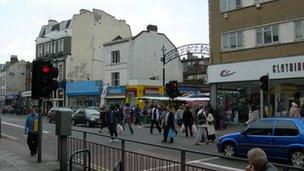Project aims to crowdsource what makes a happy city
- Published

Would you rate this as a happy, beautiful or quiet space?
A project to crowdsource the most peaceful and happy places in London has been launched by researchers at Cambridge University.
The urbangems website will ask people to compare two views from London and assess which one best represents one of three qualities - happiness, beauty and quiet.
The data will be used to create a ranking of happy places.
It could be used for better urban design, the researchers say.
Aesthetic virtues
With each selection the user is asked to guess the percentage of other people who shared their view.
They will also be able to add tags and more information to explain their choices in greater detail.
"With a comprehensive list of aesthetic virtues at hand, we would be more likely to systematically understand and recreate the environments we intuitively love," said lead researcher Daniele Quercia, from Cambridge University's Computing Laboratory.
The project will use publicly available images from services such as Google's StreetView. It had initially used images from Flickr but the quality varied too much, and researchers were concerned this could influence people's perception of a picture.
Urban decay
The long-term plan is that the site can start to offer personalised recommendations of city spaces. Users will also be able to upload and tag pictures of their own "happy spaces" to create what the researchers describe as "like a dating website that matches Londoners to their most suitable urban oasis".

Social scientists could use the data to assess why some neighbourhoods are more desirable
It is also hoped the data will inform social scientists about why some places are perceived as more desirable areas than others.
"There has been extensive research on the link between how people perceive an area and social depravation such as the famous 'broken window' theory put forward in the 80s suggesting that visual cues of public disorder - like smashed windows - can increase the risk of crime and urban decay because they set a precedent in the area," said Mr Quercia.
"What we want to do is try and drill down to those visual cues that increase people's sense of well-being in a particular area, to see if we can help build a list of key aesthetic elements that might act in the opposite manner, promoting pleasure and pride in urban environments."
- Published29 March 2012
- Published8 March 2012
- Published13 September 2011